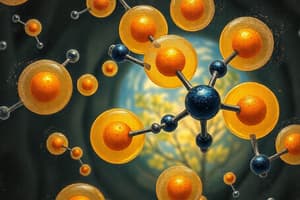Podcast
Questions and Answers
Which of the following is NOT considered a key system in human biology?
Which of the following is NOT considered a key system in human biology?
- Respiratory
- Digestive (correct)
- Reproductive (correct)
- Circulatory
What is the main mechanism by which evolution occurs?
What is the main mechanism by which evolution occurs?
- Mutation
- Artificial Selection
- Natural Selection (correct)
- Genetic Drift
What is the term for the variety of life in an area?
What is the term for the variety of life in an area?
- Genetic Diversity
- Biodiversity (correct)
- Species Diversity
- Ecosystem Diversity
Which of the following is NOT a level of organization studied in ecology?
Which of the following is NOT a level of organization studied in ecology?
What is the process by which the human body maintains a stable internal environment?
What is the process by which the human body maintains a stable internal environment?
Which of the following is NOT a characteristic of eukaryotic cells?
Which of the following is NOT a characteristic of eukaryotic cells?
What is the primary function of carbohydrates in living organisms?
What is the primary function of carbohydrates in living organisms?
Which stage of cellular respiration produces the majority of ATP?
Which stage of cellular respiration produces the majority of ATP?
What is the role of chlorophyll in photosynthesis?
What is the role of chlorophyll in photosynthesis?
What is the central dogma of molecular biology?
What is the central dogma of molecular biology?
Flashcards
Prokaryotic Cells
Prokaryotic Cells
Cells that lack a nucleus and membrane-bound organelles, like bacteria.
Eukaryotic Cells
Eukaryotic Cells
Cells that have a nucleus and membrane-bound organelles, found in animals and plants.
Cellular Respiration
Cellular Respiration
The process where cells break down glucose to release energy (ATP).
Photosynthesis
Photosynthesis
Signup and view all the flashcards
Central Dogma of Molecular Biology
Central Dogma of Molecular Biology
Signup and view all the flashcards
Mutation
Mutation
Signup and view all the flashcards
Ecology
Ecology
Signup and view all the flashcards
Natural Selection
Natural Selection
Signup and view all the flashcards
Homeostasis
Homeostasis
Signup and view all the flashcards
Biodiversity
Biodiversity
Signup and view all the flashcards
Study Notes
Cell Structure and Function
- Cells are the basic units of life, exhibiting a wide range of structures and functions.
- Prokaryotic cells, like bacteria, lack a nucleus and membrane-bound organelles.
- Eukaryotic cells, including those of animals and plants, have a nucleus and membrane-bound organelles.
- Organelles within cells have specialized functions, such as energy production (mitochondria) and protein synthesis (ribosomes).
- Cell membranes are selectively permeable, regulating the passage of substances into and out of the cell.
Biological Molecules
- Four major classes of biological molecules are carbohydrates, lipids, proteins, and nucleic acids.
- Carbohydrates are composed of carbon, hydrogen, and oxygen, serving as a primary energy source.
- Lipids (e.g., fats, oils) are hydrophobic and play important structural and energy storage roles.
- Proteins are composed of amino acids, carrying out a diverse range of functions like catalysis, transport, and structural support.
- Nucleic acids (DNA and RNA) store and transmit genetic information.
Cellular Respiration
- Cellular respiration is the process by which cells break down glucose to release energy in the form of ATP.
- The process involves glycolysis, the Krebs cycle, and the electron transport chain.
- Glycolysis occurs in the cytoplasm, producing a small amount of ATP.
- The Krebs cycle takes place in the mitochondria, generating more ATP and releasing carbon dioxide.
- The electron transport chain uses electrons from the breakdown of glucose to produce a large amount of ATP.
Photosynthesis
- Photosynthesis is the process by which plants and some other organisms convert light energy into chemical energy in the form of glucose.
- It takes place in chloroplasts, which contain chlorophyll.
- The process involves two stages: the light-dependent reactions and the light-independent reactions (Calvin cycle).
- Light-dependent reactions capture light energy to produce ATP and NADPH.
- Light-independent reactions use ATP and NADPH to convert carbon dioxide into glucose.
Genetics
- Genes are segments of DNA that contain instructions for making proteins.
- DNA is organized into chromosomes and carries genetic information.
- The process of DNA replication ensures that genetic information is passed on during cell division.
- The central dogma of molecular biology describes the flow of information from DNA to RNA to protein.
- Mutations are changes in DNA sequence, and can have various effects on traits.
Ecology
- Ecology studies the interactions between organisms and their environment.
- Various levels of organization exist, from individual organisms to ecosystems.
- Essential ecological concepts include population dynamics, community interactions, and biogeochemical cycles.
- Energy flows and nutrients cycle through ecosystems.
- Biodiversity is the variety of life in an area.
Evolution
- Evolution is the change in heritable characteristics of biological populations over successive generations.
- Natural selection is a mechanism of evolution, where traits that enhance survival and reproduction become more common in a population.
- Genetic variation is essential for evolution to occur.
- Evolutionary history is documented by fossils and comparative anatomy.
- Phylogenetic trees illustrate evolutionary relationships between organisms.
Human Biology
- Human biology investigates the structure and function of the human body.
- Key systems include the circulatory, respiratory, digestive, nervous, and endocrine systems.
- Homeostasis maintains internal stability in the human body.
- Diseases and disorders can affect various systems within the human body.
- Human development spans from conception to death.
Studying That Suits You
Use AI to generate personalized quizzes and flashcards to suit your learning preferences.




